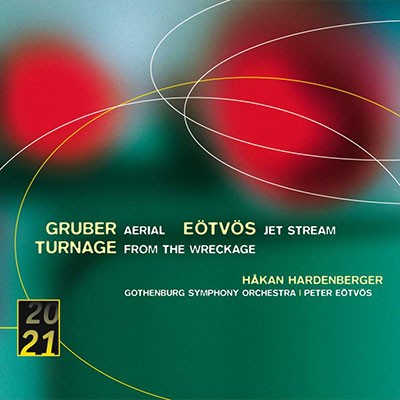3(II,III=picc).2.4(III=Ebcl,IV=bcl).asax(=ssax).tsax(=ssax).2.dbn-
4.3.3.1-timp.perc(3):I=drum kit/crot/lg chinese tam-t; II=vib/glsp/
xylorimba; III=marimba/xylorimba-pft-strings
NB: solo trumpet also plays piccolo trumpet in Bb and cow horn.
Abbreviations (PDF)
Boosey & Hawkes
HK Gruber collaborated closely with Håkan Hardenberger on preparing the solo part, and the trumpeter's skills are stretched not only in terms of virtuosity, stamina and the use of multiple mutes, but also through the requirement for the soloist to play cowhorn as well as trumpet and piccolo trumpet, to play with slides removed, and to sing and play simultaneously.
The concerto offers two aerial views, firstly an imaginary landscape beneath the Northern Lights bearing an inscription from the Emily Dickinson poem Wild Nights: "Done with the Compass – Done with the Chart!" In part this refers to the pure invention that can be conjured up through the skills of a great trumpeter, with Hardenberger here as the magician, casting an incantatory spell (perhaps with a little help from his native troll art?). The concerto opens with the trumpeter playing and singing the work into being, conjuring up the mythological image of the creation of music as Pan blows into the reed into which the nymph Syrinx has been transformed. The orchestra takes up this opening material as the soloist in cadenza fashion explores the notes available with slideless playing, providing a sonic bridge to the entry of the cowhorn which functions as an ur-brass instrument from a lost age. The title of this movement also has clear significance for Gruber, whose works have increasingly met the challenge of hiding complex compositional procedures in the background, so that the musical surface is freed to be both spontaneous and engaging.
The second and larger of the two aerial views, entitled Gone Dancing, provides an energetic contrast, with glimpses of two exuberant examples of ‘light’ music at its best, but viewed as if from another planet - our world is empty of human life, but a lone sign bears the words "Gone Dancing". The movement opens in the West in the 1940s with Fred and Ginger creating a toe-tapping dance dialogue, and this moves into outdoor folkmusic of a distinctly Eastern hue with the soloist progressively assuming the role of leader of the village band.
"Aerial is a weird, wondrous, exhilarating tour de force."
Chicago Tribune
"…a dazzling display of compositional technique...Gruber succeeds in evoking an extraordinarily beautiful sound world… [he] weaves a musical tapestry bristling with wit and invention, punctuated with telling silences and animated by syncopations that suggest a world out of kilter."
The Times
"The concerto works as both a virtuoso vehicle and as a brilliantly contrasted pair of sound pictures, miniature tone poems almost… when played by someone with Hardenberger’s magisterial command it is a dazzling showpiece…"
The Guardian

Håkan Hardenberger / Gothenburg Symphony Orchestra / Peter Eötvös
DG CD 477 615-0

